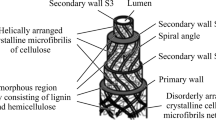Abstract
The effects of physical adhesion on the mechanical properties of a composite structure are examined in this work. A criterion for optimum adhesion between matrix and reinforcing fibres is proposed based on maximizing the wetting tension. It is shown that the maximum wetting tension criterion best fulfils two important requirements for a strong interface:(i) the physical interactions at the molecular level between the resin and the fibres must be maximized, and (ii) the liquid resin must spontaneously wet the fibre surface in order to minimize the flow density at the interface. The conditions on the surface energy of the various phases leading to maximum wetting tension are analysed considering three mixing rules: two based on dispersive–polar interactions, and a third one based on acid–base interactions. The optimum adherend for a given adhesive, and the optimum adhesive for a given adherend, are examined. The analysis shows that maximum wetting tension is obtained when the substrate and adhesive surface energies are very high and equal, so that their polar and dispersive components are equal when the polar–dispersive mixing rule is used, and e.g. their Lifshitz–van der Waals’ components are equal and the acid component of one phase is equal to the basic component of the other phase when the acid–base approach is considered. It is shown using data from the literature that interfacial strength correlates with the wetting tension for fibre reinforced composites. Additional observations show that under poor wetting conditions the voids tend to concentrate at the fibre–resin interface, whereas under favourable wetting conditions they tend to coalesce in regions away from the fibre surface.
Similar content being viewed by others
References
V. R. RILEY, J. Compos. Mater. 2 (1968) 436.
W. A. FRASER, F. H. ANCKER, A. T. DIBENEDETTO and B. ELBIRLI, Polym. Compos. 4 (1983) 238.
M. S. MADHUKAR and L. T. DRZAL, J. Compos. Mater. 25 (1991) 932.
M. R. PIGGOTT, Comp. Sci. Technol 30 (1987) 295.
L. T. DRZAL, M. J. RICH and P. F. LLOYD, J. Adhesion 16 (1982) 1.
N. L. HANCOX, J. Mater. Sci. 10 (1975) 234.
I. VERPOEST and G. S. SPRINGER, J. Reinforced Plastics Compos. 7 (1988) 23.
L. T. DRZAL and P. J. HERRERA FRANCO, in “Engineered materials handbook” Vol. 3 “Adhesive and sealants” edited by C. A. Dostal (American Society for Metals, Metal Park, OH, 1990) 391.
J. P. FAVRE, in the Conference on Interfacial Phenomena in Composite Materials, Sheffield, (1989) p. 7.
M. R. PIGGOTT and M. M. REBOREDO, in the 34th International SAMPE Symposium (1989) p. 1923.
A. N. GENT and A. J. KINLOCH, J. Polym. Sci. 9 (1971) 659.
A. N. GENT and J. SCHULTZ, J. Adhesion 3 (1972) 281.
W. A. ZISMAN, in “Contact Angle, wettability and adhesion”, Advances in Chemistry Series Vol. 43 (American Chemical Society, Washington, DC 1964).
S. WU, J. Adhesion 5 (1973) 39.
Y. KITAZAKI and T. HATA, J. ibid. 4 (1972) 123.
V. R. GRAY, Chem. Ind. (1965) 969.
Idem, Forest Product J. 12 (1962) 452.
M. CONNOR, S. TOLL and J.-A. E. MÅNSON, Compos. Manuf. 6 (1995) 289.
J.-E. BIDAUX, G. D. SMITH, N. BERNET, J. HILBORN and J.-A. E. MÅNSON, Polymer 37 (1996) 1129.
K. JUD, H. H. KAUSCH and J. G. WILLIAMS, J. Mater. Sci. 16 (1981) 204.
J. C. BERG, in “Wettability”, edited by J. C. Berg (Dekker, New York 1993) p. 75.
A. DUPRÉ, “Théorie mécanique de la chaleur” (Gaitjoer- Villars, Paris. 1869).
T. YOUNG, Phil. Trans. 95 (1805) 82.
L. E. RARATY and D. TABOR, Proc. Roy. Soc. 245A (1958) 184.
M. LEVINE, G. ILKA and P. WEISS, J. Polym. Sci. Polym. Lett. Ed. B-2 (1964) 915.
M. J. BARBARIS, Nature 215 (1967) 383.
M. NARDIN, E. M. ASLOUN and J. SCHULTZ, J. Polym. Adv. Technol. 2 (1991) 171.
S. WU, “Polymer interfaces and adhesion” (Dekker, New York 1982) Ch. 11.
N. A. DE BRUYNE, Nature 10 (1957) 262.
K. L. MITTAL, Polym. Eng. Sci. 17 (1977) 467.
A. W. NEUMANN, Staub-Reinhaltung der Luft 28 (1968) 24.
G. A. DYCKERHOFF and P.-J. SELL, Angew. Makromol. Chem. 21 (1972) 169.
D. DRIEGGER, A. W. NEUMANN and P. J. SELL, Kolloid Z. u. Z. Polymere 201 (1965) 52.
P. J. SELL and A. W. NEUMANN, Angew. Chem. 78 (1966) 321.
L. A. GIRIFALCO and R. J. GOOD, J. Phys. Chem. 61 (1957) 904.
R. J. GOOD and E. ELBING, Ind. Eng. Chem. 62 (1970) 55.
R. J. GOOD, “Contact angle, wettability, and adhesion”, Advances in Chemistry series, Vol. 43 (American Chemical Society, Washington, DC, 1964) p. 74.
Idem. in “Treatise on adhesion and adhesives” Vol. 1, edited by R. L. Patrick (Dekker, New York, 1967) p. 9.
Idem. in “Contact angle, wetting and adhesion”, edited by K. L. Mittal (VSP, Utrecht, 1993) p. 3.
M. CONNOR, P. H. HARDING, J. C. BERG and J.-A. E. MÅNSON, J. Adhesion Sci. Technol. 9 (1995) 983.
M. ASLOUN, Ph. D thesis, Université de Haute Alsace, France (1991).
R. A. BUCHER and J. A. HINKLEY, J. Thermopl. Compos. Mater. 5 (1992) 3.
D. J. HODGE, B. A. MIDDLEMISS and J. A. PEACOCK, Mater. Res. Soc. Symp. Proc. 170 (1990) 327.
M. NARDIN, E. M. ASLOUN, F. MULLER and J. SCHULTZ, Polym. Adv. Technol. 2 (1991) 161.
Author information
Authors and Affiliations
Rights and permissions
About this article
Cite this article
CONNOR, M., BIDAUX, JE. & MANSON, JA.E. A criterion for optimum adhesion applied to fibre reinforced composites. Journal of Materials Science 32, 5059–5067 (1997). https://doi.org/10.1023/A:1018657131178
Issue Date:
DOI: https://doi.org/10.1023/A:1018657131178




